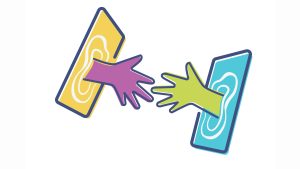
There are some guidelines for young children (see below), but there is no exact number for how much screen time is okay at all ages. To understand how much is too much for your child, there are some factors to consider. These include content quality, the context around screen use, and individual factors unique to your child.
Experts do agree on a few guidelines for young children:
- 0 – 18 months: No screen time, except for video chatting with loved ones. (Video chatting is generally excluded from screen time restrictions.)
- 18 – 24 months: Very limited screen time, high-quality educational content only. At this age, screen time should always be co-viewed with a parent or caregiver.
- 2 – 5 years: Limit screen use to no more than 1 hour per day. High-quality educational content is best, but some recreational use is okay. Co-viewing or co-playing with a parent, caregiver, or educator is still recommended.
I always like to say communication over restriction. Restricting our kids’ content is difficult. It’s difficult when media is continuously changing. It’s difficult when our kids are far more tech savvy than we are. Sometimes it’s difficult when they get older and they are spending more time at other people’s houses or just outside the home. So communication over restriction, I think, is key.

For children 5 years and older, there is no consensus on healthy time limits. A general rule of thumb is that screen time should not displace other activities important for health and well-being. These include sleep, physical activity, family time and social interactions. As children get older, talk to them about how their screen time is or is not serving their needs. Encourage healthy habits and balance between screen and non-screen activities.
Experts also agree that it’s important to look beyond screen time alone. Consider the type of content your child is engaging with, prioritizing high-quality content and media use that facilitates learning or social connection. Assess the context of use, including the time of day, what else is going on around the child, and what activities the media use is either facilitating or interfering with. Finally, be aware of the specific child’s needs and how these intersect with their online and offline activities.
Instead of saying “You’re addicted to your phone, I’m taking it away,” you can try suggesting they use the time management apps, gently reminding them that it’s important to finish tasks and attend their priorities first. Instead of saying “You spend all of your time on your phone and never talk to your family,” make usage restrictions minimal – immediately taking away your child’s devices or access to social media can make healthy habits harder to sustain, and makes them less eager to participate.






